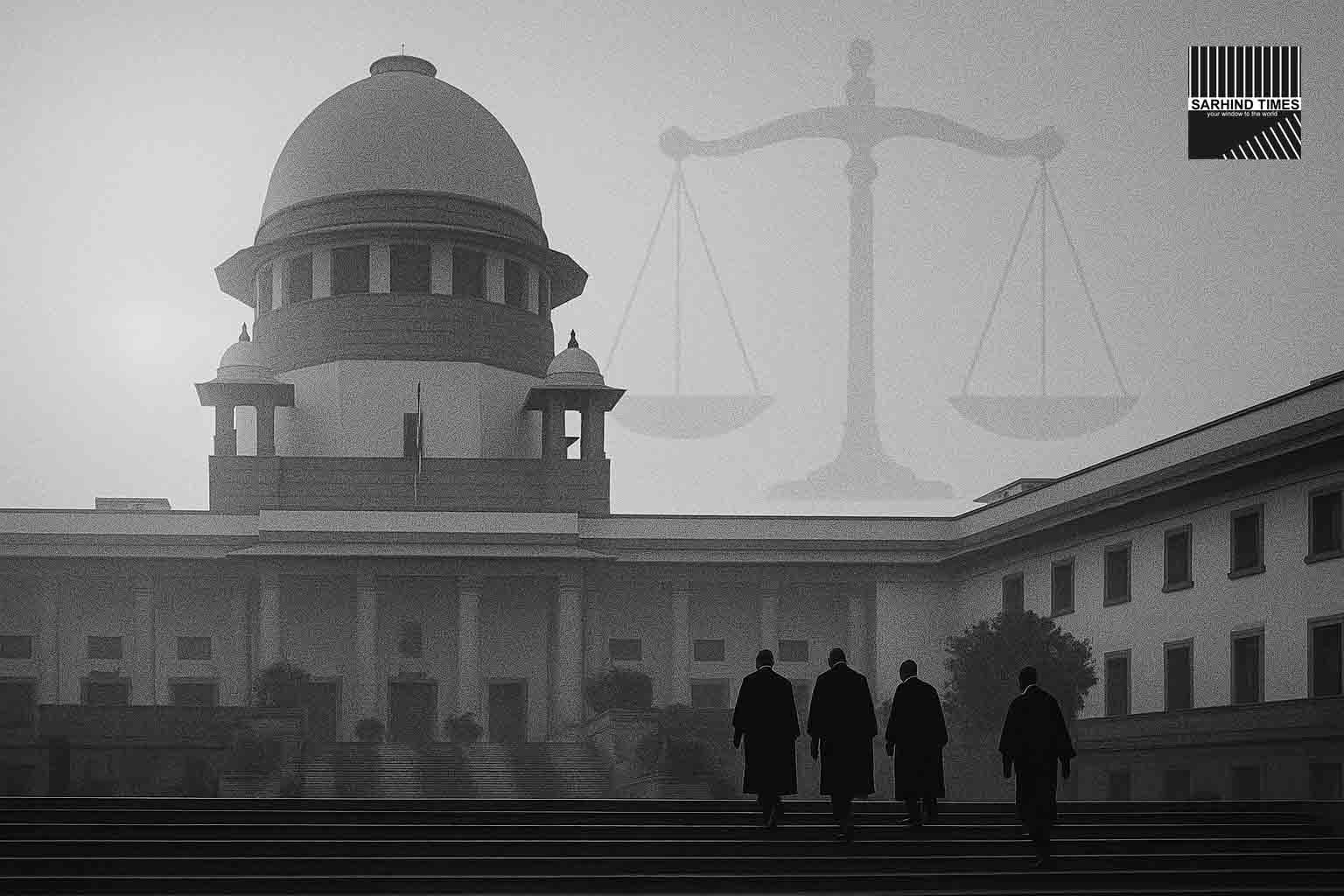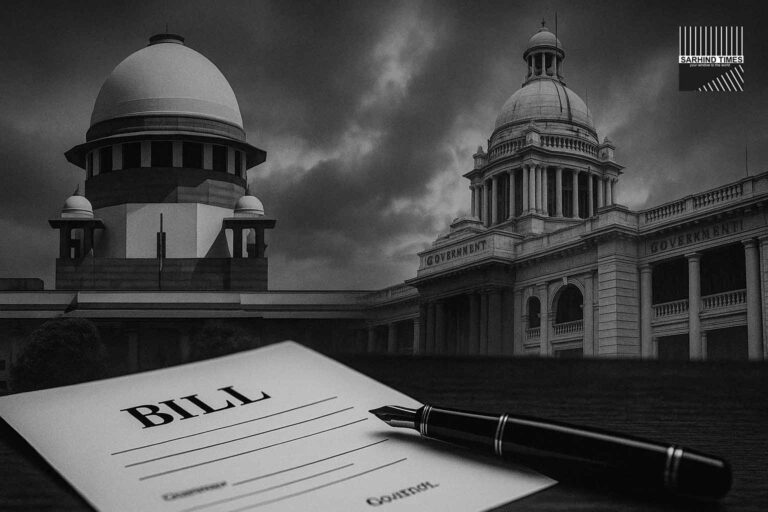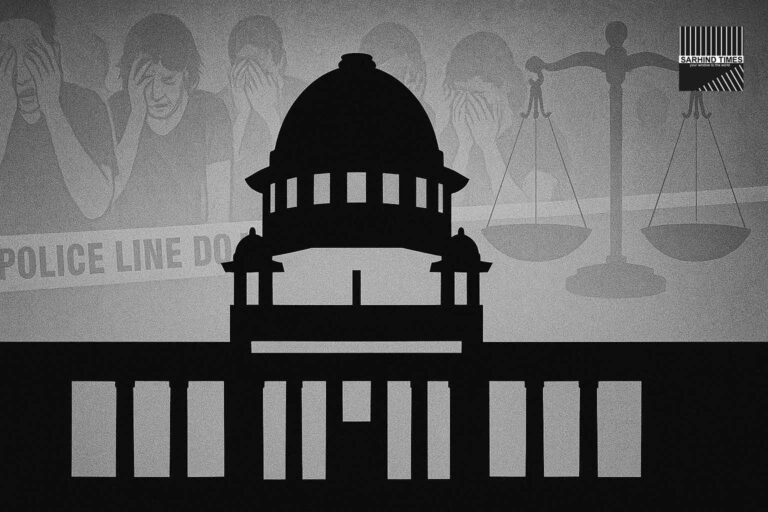Historic ruling expands eligibility by recognizing prior advocacy experience of serving judicial officers — a landmark for India’s judiciary talent pipeline.
By SarhindTimes Bureau
New Delhi, October 2025
A Judgment that Redraws Judicial Career Maps
In a judgment hailed as a structural reform for India’s judiciary, the Supreme Court of India has ruled that serving judicial officers who have completed seven years of practice as advocates before joining the service are eligible to apply for District Judge positions.
The verdict, delivered by a three-judge Bench led by Justice Sanjiv Khanna, resolves a long-standing ambiguity that had excluded many experienced trial-court judges from upward mobility, despite their significant legal experience before joining the bench.
This decision is expected to broaden the talent base, improve career progression pathways, and address chronic vacancies in India’s district judiciary — the backbone of the justice delivery system, where pendency continues to strain access to timely justice.
Background: The Seven-Year Question
For decades, the interpretation of the “seven years’ practice as an advocate” clause under Article 233(2) of the Constitution has been a point of contention.
The Article lays down that an individual shall be eligible for appointment as a District Judge if he or she has been an advocate or pleader for not less than seven years and is recommended by the High Court.
The conflict arose when serving judicial officers, many of whom had prior experience as advocates before entering the lower judiciary, were deemed ineligible for District Judge recruitment under the “direct from the bar” quota.
This exclusion created a peculiar imbalance — experienced judicial officers were barred from advancing due to technical interpretation, even though they possessed the requisite years of advocacy experience.
The Supreme Court’s Clarification
In its ruling, the apex court held that experience at the Bar before joining judicial service must be recognized while assessing eligibility for higher judicial appointments.
“Judicial officers who have completed seven years as advocates prior to entering service cannot be deprived of consideration solely due to their current designation,”
the Bench observed, emphasizing that such officers carry both barroom and courtroom experience, a valuable combination for the District Judge’s role.
The judgment harmonizes conflicting interpretations from various High Courts and clarifies the constitutional intent — that practical legal experience, not bureaucratic tenure, determines fitness for the position.
Impact: Expanding the Talent Pipeline
Legal experts say this ruling is transformative for the district judiciary, which is currently operating with over 5,000 vacancies nationwide.
By expanding the eligible pool to include officers with prior bar experience, the Supreme Court has effectively opened a new channel for filling posts that often remain vacant due to narrow eligibility definitions.
“The decision broadens the base of qualified candidates while preserving merit,”
said Senior Advocate Ramesh Gupta, former Delhi Bar Council Chairman.
“Many capable judges joined the subordinate judiciary early, after years at the Bar. Their exclusion was unjustified. This balances institutional memory and new energy.”
Judiciary’s Core Challenge: Vacancies and Pendency
India’s judiciary faces persistent strain from case pendency exceeding 5 crore cases, with district and subordinate courts accounting for nearly 87% of the total.
Despite ongoing recruitment drives, delays in appointment processes, combined with eligibility bottlenecks, have hindered replenishment of the judicial workforce.
According to data from the Department of Justice, as of mid-2025, India’s sanctioned strength of district judges was approximately 25,500, while actual working strength hovered around 20,200.
The new judgment could help accelerate recruitment, giving High Courts and State Public Service Commissions greater flexibility to fill vacant seats.
Bar and Bench Welcome the Decision
The Bar Council of India (BCI) and several state bar associations have welcomed the ruling as a “progressive interpretation” that honors advocacy as a foundation of judicial wisdom.
“Advocates are trained to think on their feet and interpret the law dynamically. Recognizing their prior experience gives our judicial ecosystem more diversity,”
said BCI Chairperson Manan Kumar Mishra.
High Court judges and administrative officials also see merit in the reform.
“This interpretation allows us to select from a richer, more experienced pool,”
said a senior registrar from the Allahabad High Court.
“The system benefits when experience is cumulative, not compartmentalized.”
Balancing Experience and Integrity
While the decision is being celebrated, legal experts caution that eligibility expansion must be paired with strong vetting and training mechanisms.
“The quality of justice depends not just on years of service, but the depth of judgment,”
said Justice (Retd.) Kurian Joseph, former Supreme Court judge.
“New entrants must undergo refresher training in case management, digital courts, and ethics.”
The National Judicial Academy (NJA) in Bhopal is expected to integrate new modules for officers transitioning from lower judicial roles to district court positions, focusing on digital caseflow systems, evidence handling, and courtroom leadership.
Legal Reasoning: Harmonizing Statutory and Constitutional Text
The Court’s reasoning reflects a nuanced approach to constitutional interpretation.
It reaffirmed that Article 233(2) does not impose an “absolute bar” against serving judicial officers with prior bar experience. Instead, it clarifies that the spirit of the Article is to ensure a minimum seven-year legal practice, whether continuous or cumulative, before assuming the District Judge’s responsibilities.
The Court distinguished between:
- Direct recruits from the Bar, who must currently be practicing advocates; and
- Judicial officers with prior bar experience, who have already crossed the seven-year threshold before joining service.
The Bench emphasized that denying the latter category would defeat the Article’s objective of balancing professional diversity in the judiciary.
Administrative Implications: Policy Realignment Ahead
The verdict will now require the High Courts and State Public Service Commissions (PSCs) to recalibrate their recruitment frameworks.
In many states, the District Judge recruitment notification explicitly barred serving officers from applying under the “advocate” quota. With this ruling, such notifications must be amended.
An official from the Department of Justice (DoJ) said the verdict provides a “legal anchor” for upcoming reforms under the National Judicial Services Framework, which seeks to standardize appointments and training.
“The ruling removes ambiguity and strengthens human resource planning for the judiciary,” the official said.
Bar Councils Seek Transparent Selection
Bar councils have urged that the expanded eligibility not dilute selection standards. They advocate for clear, merit-based criteria emphasizing written exams, interviews, and integrity checks.
“Transparency and competence must remain non-negotiable,”
said Adv. Shalini Ghosh, member of the Calcutta High Court Bar Association.
“The judiciary’s strength lies in credibility — and that begins with how judges are chosen.”
The BCI has also proposed a joint screening framework with High Courts to ensure that bar experience claimed by candidates is authentic and well-documented.
A Step Toward Judicial Career Fluidity
The decision is part of a broader debate about how India’s judicial career ladder should evolve. Currently, most judicial officers spend decades in subordinate courts before being considered for promotion to the District or High Court level.
Legal scholars believe this ruling could encourage more lateral movement, allowing advocates with rich trial experience to bring fresh perspectives into the higher judiciary.
“Career fluidity strengthens institutional learning,”
said Prof. Ritu Mathur, who teaches constitutional law at NLU Delhi.
“A judge who has argued from the Bar and served on the Bench understands both sides of the justice equation.”
Parallel Reforms: Digital Caseflow & Training
While the eligibility expansion is a major win, experts caution that broader reforms will determine its ultimate impact.
Projects like Phase-III of the eCourts Mission Mode Project, AI-based case allocation, and digital witness support systems are central to improving productivity.
District judges, often the administrative heads of multiple courts, must now master both traditional adjudication and modern data-driven governance.
“Judicial training must evolve from doctrinal learning to managerial leadership,”
said Justice (Retd.) Rajesh Tandon, former High Court judge.
“This verdict adds human capital, but the system needs skill capital too.”
Comparative Perspective: Lessons from Other Jurisdictions
Globally, most common law jurisdictions, including the UK and Australia, allow career judges to apply for higher positions based on cumulative legal experience, including advocacy years.
India’s earlier narrow interpretation had limited such fluidity.
This judgment brings India closer to international best practices, emphasizing competence and cumulative experience over rigid service classifications.
“The decision aligns with the spirit of meritocracy that modern judiciaries embrace,”
observed Dr. Ananya Singh, a comparative law scholar at Oxford University.
Voices from the Ground: Hope for the Subordinate Judiciary
For thousands of judicial officers serving in rural and semi-urban courts, the ruling offers long-awaited recognition.
“We joined to serve justice, but career ceilings were disheartening,”
said a civil judge from Madhya Pradesh, requesting anonymity.
“Now we have a reason to aspire higher.”
Legal aid lawyers also hope that diversity in the District Bench will make it more empathetic to grassroots realities.
“Judges who have seen the Bar know how the system treats marginalized litigants,”
said Adv. Farhan Siddiqui, legal aid counsel in Lucknow.
“It’s good for justice delivery at the human level.”
Criticism: Fear of Overlap and Confusion
Not everyone is convinced. Some administrative officers within the judiciary worry the expanded eligibility may blur distinctions between promotion quota and direct recruitment quota, leading to procedural confusion.
“The service quota is meant to reward seniority within the system,”
said an officer from the Gujarat High Court establishment.
“Merging categories might trigger disputes over seniority and pay scales.”
Experts recommend a clear administrative guideline from the Supreme Court or the Department of Justice to prevent overlaps and ensure uniform implementation.
Way Forward: From Ruling to Reform
The Court’s judgment is more than a technical clarification; it’s a signal for institutional rejuvenation.
Recruitment notifications, service rules, and examination syllabi will now need urgent revision to reflect the expanded eligibility.
States like Uttar Pradesh, Tamil Nadu, and Maharashtra — which have major judicial vacancies — are expected to be early adopters.
The High Court of Delhi has already announced that its next District Judge examination cycle will incorporate the ruling’s interpretation, with updated eligibility criteria.
Editorial Analysis: A Step in the Right Direction
The Supreme Court’s decision reflects judicial realism — an acknowledgment that law and justice are lived professions, not static hierarchies.
By blending prior advocacy experience with current judicial service, the Court has ensured that talent, not technicality, defines opportunity.
Still, this victory must not end in complacency. It must be matched with:
- Transparent selection panels
- Standardized training for new District Judges
- Technological empowerment of courts
- Ethical reinforcement in promotion mechanisms
Only then will this judgment translate from paper to performance in India’s 700-odd district courts.
Conclusion: A Door Opens for Judicial Aspiration
The Supreme Court has opened a long-shut door for thousands of deserving officers and advocates who straddle both sides of the justice system.
For India, where the strength of democracy rests on the credibility of its courts, this ruling represents both a symbolic and practical win — ensuring that the pursuit of justice remains open to those who have devoted their lives to it, whether at the Bar or the Bench.
“Justice grows stronger when experience is not fenced off,”
the Bench concluded — a line that may echo through judicial corridors for years to come.
#SupremeCourt #Judiciary #Law #DistrictCourts #JusticeReform #India #LegalReform #JudicialVacancies #BarAndBench #ConstitutionalLaw

























+ There are no comments
Add yours